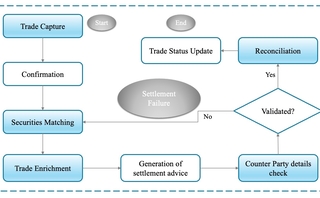Waters Wrap: What’s next for desktop interop?
Anthony takes a look at the desktop application interoperability space—how we got here and where he thinks it's going.

In October 2017, a group of banks, asset managers and vendors in the capital markets began working on a project to create “the equivalent of the FIX protocol for desktops.” The collective, which was led by desktop app interoperability vendor OpenFin, met about once every two weeks to get the project off the ground.
The aim was to enable interoperability between applications that sit on the financial desktop, and it works by codifying standard patterns that app developers use for cross-application workflows between web and native apps. Essentially, they wanted to create an ecosystem for financial workflows to interoperate in plug-and-play fashion without prior bilateral agreements, similar to the way that apps on an iPhone can interact and share information across one another.
In March 2018, the group officially unveiled the Financial Desktop Connectivity and Collaboration Consortium, known better as FDC3. At launch, the group included banks and brokers like Barclays, JPMorgan, Morgan Stanley, Royal Bank of Canada (RBC) and TP Icap; buy-side firms such as AllianceBernstein and Citadel; and vendors including Algomi, ChartIQ, Cloud9 Technologies, FactSet, Fidessa, GreenKey and OTAS Technologies.
As Kim Jaffee Prado, then a senior technologist at RBC Capital Markets (now CIO of BMO’s capital markets’ operations), told me at the time, “My hope is that [FDC3] sticks. If more fintech companies work with OpenFin, we can eventually reach an optimum point where OpenFin has an app store and companies like ours say, ‘What chat applications are wrapped in OpenFin? Ok, these five—let’s try that one,’ and download it.”
Those were halcyon days—an era defined by everyone seemingly working together toward a common good.
Size matters
My career as a journalist spans more than two decades, and in that time, I’ve interviewed well over 1,000—I’d bet over 10,000—people for stories about technology, banking, boxing, little league baseball, local government, library renovations and even GPS trackers for 18-wheelers. I’ve forgotten roughly 99% of those interactions, but I remember the discussions I had about the launch of FDC3. It found it to be a very interesting project, and I vividly remember the conversation I had with Mazy Dar, the CEO of OpenFin.
The interview was over the phone, but I had met him several times prior. He can come off a bit earnest—if not intense—because he really wants you to understand his vision for the company he runs. As I’ve written previously, I have a lot of respect for what he’s done since launching OpenFin in 2010. His company led the charge on a technology that became its own category of technologies—desktop application interoperability. And it was his company that led the development of FDC3, which is now sits under the governance of the Fintech Open Source Foundation, or Finos. (I’m going to get to the story we wrote about OpenFin’s commitment to FDC3, but allow me to set the scene.)
And as with any successful endeavor, it was only a matter of time until others saw an opening to be disruptive. Five years after the launch of OpenFin, a vendor named Glue42 (then Tick42) decided to enter the market with the product that would become its namesake. And a few months before development on FDC3 began, charting vendor ChartIQ launched a product named Finsemble, which also took aim at the desktop interop crowd. A trifecta of vendors took control of the space—at times working as partners and at times working as bitter rivals.
Flash forward to last month—Glue42 and Finsemble (which is what ChartIQ became soon after it was rebranded to Cosaic … please don’t get me started) decided to merge, creating a new company called Interop.io. (For the record, I’m not a fan of company names including the .io domain, but I’m not in marketing, so what do I know?)
To me, the pairing up of Finsemble and Glue42 made complete sense—it has to do with size. While there are no official metrics, OpenFin has held the dominant market position of the trio. But if you’d like some evidence, let’s take a look at what’s been publicly announced. (Note: Please forgive me, but I’m not going to link to each announcement, but the information is easily attainable if you want more detail.)
According to Crunchbase—which doesn’t provide official numbers but gives a decent enough starting point—OpenFin has raised $81.3 million in funding over the years. In its most recent press release, OpenFin announced a $35 million Series-D round funding round. According to that release, its current investors counts several banks (or the VC arms of banks), including Bank of America, Barclays, HSBC, ING, JPMorgan, Standard Chartered and Wells Fargo. The vendor has also announced partnerships with BNP Paribas, Broadridge, FactSet, London Stock Exchange Group, and, four years ago, I wrote a profile of RBC’s desktop app interop project with OpenFin. This is all to say that there are a lot of big names attached to OpenFin.
Finsemble/Cosaic, according to Crunchbase, has raised $27.2 million. Citi is an announced lead investor and user, and it has public projects with Charles River, among other tech and data providers. As for Glue42, funding stats aren’t readily available, but they do have public partnerships with AllianceBernstein, BNY Mellon and Broadridge.
(I must note that I have no clue if all the announced partnerships for OpenFin, Finsemble or Glue42 are still alive. But those announcements do show that there was a time when the belief in desktop interop hung thick in the air.)
This all to say that, in my humble opinion, it didn’t make sense for Finsemble and Glue42 to battle against each other and OpenFin, a larger opponent. It makes far more sense to combine financial resources, talent and already-developed tools in a sector where there isn’t room for a bevy of providers. After all, the whole point of desktop application interoperability is uniformity and consolidation, right?
Where do we go now?
Okay. It took about 1,000 words, but the stage has been set. After speaking with a handful of people in the industry—none of whom are Dar, Finsemble’s Dan Schleifer or or Glue42’s Leslie Spiro (at least for this story, anyway)—below are the questions I have.
* What does this merger say about the state of the desktop app interop space? If there wasn’t room for three players, is there room for two players? Or even one? I’ve heard several people speculate that these firms could be acquisition targets for workflow/collaboration vendors—i.e., Symphony or LSEG (through Refinitiv’s Workspace platform).
* At the same time, you have an interesting new entrant into the interop space called Connectifi, except that company wants to take interop off of the desktop and bring it to the cloud—a stark divergence from what has traditionally been built around container technology, such as Electron. At a time when seemingly every vendor, bank, asset manager and exchange is moving to the cloud, are companies like OpenFin and Interop.io at risk of falling out of favor if they’re too locked into the desktop? It’s also important to remember that FDC3 is the brainchild of OpenFin alum Nick Kolba, the founder and head of Connectifi. I want to know: what does he see that others don’t?
* For what it’s worth, I think there’s a lane for both versions as banks won’t be getting rid of their desktops anytime soon, no matter how much they love to say that they’re all-in on the cloud. But one industry consultant who works closely with major banks told me that the challenge desktop app interop vendors face is that when the project is successful, the stickiness isn’t there to keep pushing deeper into the bank.
“For any of these companies, what’s their sales cycle going to look like five years from now?” they asked me.
I guess we’ll find out over the next five years. Are OpenFin and Interop.io still two independent companies that have carved up the largest banks and asset managers between the two companies, or have they merged? Or, is the space actually so viable that other startups see an opportunity to enter the market and nip at the heels of OpenFin and Interop.io. I mean … that’s already happening with Connectifi, right?
* But here’s where things get even more interesting: OpenFin has already announced that it has expanded into the government sector. Schleifer told our Reb Natale that Interop.io has seen demand for their products outside of capital markets and finance. And Kolba, too, has told us that he believes that the platform that he’s building can be applied to other industries beyond Wall Street. Connectifi closed its seed round last month with investment from two VCs that do not typically focus on financial markets tech, Blumberg Capital and Engineering Capital, both of which are based in Silicon Valley.
Why are these companies so interested in expanding their horizons? Has the market already been tapped for trading firms? Or is it just good business to diversify revenue streams?
It reminds me a little bit of Symphony, which—to greatly simplify this—was essentially created (out of a company then-called Perzo) by a bunch of banks to build an industry-specific communication platform that wasn’t Bloomberg Chat. The company was, at one point, also looking to expand beyond the capital markets but has since reined in its focus to its original goal.
Is it better to have a laser-like focus on capital markets, or does that create concentration risk? I guess these are the decisions to be made by these executives going forward, but just as OpenFin was first out of the gate on desktop app interop, they appear to be first out of the gate on cross-industry expansion.
* I’ve known Schleifer for many years. He’s a very bright guy, and I think that can be seen in how he’s (alongside co-founder Terry Thorsen) evolved the company. ChartIQ, as the name would suggest, is a hardcore HTML5 charting library that was bought by S&P Global earlier this year to bolster S&P’s Capital IQ desktop workstation. Despite that being the flagship product, Schleifer and Thorsen shifted the focus to Finsemble. And, as stated before, rather than go it alone against both OpenFin and Glue42, it made more sense to merge.
I don’t know Spiro as well, but we have had a few conversations over the years. Glue42 has been innovative in the interop space, which can be seen with its rollout of Core+, a zero-install web and progressive web apps (PWA)-based platform that allows interoperability between apps on different user machines, which is something that Finsemble was in the process of building for itself (but the duo will now just use the original Core+).
Schleifer is the president of Interop.io and will be responsible for overseeing sales, marketing, thought leadership and investor relations; Spiro is the CEO, overseeing product engineering and the vendor’s technical vision. What I think will be most interesting to watch is how these two smart individuals mesh, especially when the first difference of opinion comes to bear.
Combining their intellect and unique skills—Schleifer experience in sales and relationship-building with Spiro’s focus on tech—could be a formidable combination. And if they work well together, that likely means that employees from the two companies (most of whom—just over 160—have been retained by Interop.io, according to Schleifer) will work well together.
Schleifer and Spiro told Reb that the merger positions Interop.io to be the largest in their market in terms of paying clients, number of active smart desktops, revenue, and research and development teams. It should also be noted, though, that they declined to share concrete numbers to back up that claim. But, again, size matters. The pairing makes sense on paper … will it make sense from a people perspective? I think that will be the largest factor in determining success or failure.
* Finally, since we’re talking about desktop app interoperability, I must address a story that we wrote that questioned OpenFin’s commitment to FDC3. First, let me say that I fully stand by both the reporting of that story and the reason for writing it. OpenFin did end its gold membership with Finos; OpenFin’s participation in FDC3 and all other projects to which they were contributing had come to a near-halt by mid-2020; OpenFin did discontinue its public work on Hadouken, the open-source version of the OpenFin operating system that the vendor also contributed to Finos along with FDC3; and, most importantly, OpenFin did release Workspace with a new API that some felt might not be in line with the FDC3 ethos.
I jammed a lot into a small space there, but there were legitimate questions that we raised to Dar and OpenFin’s global head of marketing, Mitra Roknabadi. They vehemently denied that the vendor’s commitment to FDC3 was waning. In the story, they got to have their say; other industry participants had theirs.
Two years on, OpenFin still uses FDC3, and it has been declared by Finos to be compliant with FDC3 version 1.2 (but has not yet been certified for the latest version, FDC3 2.0). I believe that good journalism holds people and companies to account and sets the record straight. While we certainly do not retract that original story (again, there were plenty of reasons to question OpenFin’s commitment), let the record show that OpenFin is still on board with FDC3.
Think there’s anything else I should be setting the record straight on? Let me know: anthony.malakian@infopro-digital.com
The image accompanying this column is “The Chess Players” by Thomas Eakins, courtesy of The Met’s open-access program.
Only users who have a paid subscription or are part of a corporate subscription are able to print or copy content.
To access these options, along with all other subscription benefits, please contact info@waterstechnology.com or view our subscription options here: http://subscriptions.waterstechnology.com/subscribe
You are currently unable to print this content. Please contact info@waterstechnology.com to find out more.
You are currently unable to copy this content. Please contact info@waterstechnology.com to find out more.
Copyright Infopro Digital Limited. All rights reserved.
You may share this content using our article tools. Printing this content is for the sole use of the Authorised User (named subscriber), as outlined in our terms and conditions - https://www.infopro-insight.com/terms-conditions/insight-subscriptions/
If you would like to purchase additional rights please email info@waterstechnology.com
Copyright Infopro Digital Limited. All rights reserved.
You may share this content using our article tools. Copying this content is for the sole use of the Authorised User (named subscriber), as outlined in our terms and conditions - https://www.infopro-insight.com/terms-conditions/insight-subscriptions/
If you would like to purchase additional rights please email info@waterstechnology.com
More on Trading Tech
For MarketAxess, portfolio trading buoys flat revenue in Q3
The vendor is betting on new platforms like X-Pro and Adaptive Auto-X, which helped forge a record quarter for platform usage.
Quants look to language models to predict market impact
Oxford-Man Institute says LLM-type engine that ‘reads’ order-book messages could help improve execution
JP Morgan pulls plug on deep learning model for FX algos
The bank has turned to less complex models that are easier to explain to clients.
Nasdaq says SaaS business now makes up 37% of revenues
The exchange operator’s Q3 earnings bring the Adenza and Verafin acquisitions center stage.
Harnessing generative AI to address security settlement challenges
A new paper from IBM researchers explores settlement challenges and looks at how generative AI can, among other things, identify the underlying cause of an issue and rectify the errors.
The causal AI wave could be the next to hit
As LLMs and generative AI grab headlines, another AI subset is gaining ground—and it might solve what generative AI can’t.
Waters Wrap: Operational efficiency and managed services—a stronger connection
As cloud, AI, open-source, APIs and other technologies evolve, Anthony says the choice to buy or build is rapidly evolving for chief operating officers, too.
BlackRock forecasts return to fixed income amid efforts to electronify market
The world's largest asset manager expects bond markets to make headway once rates settle.








